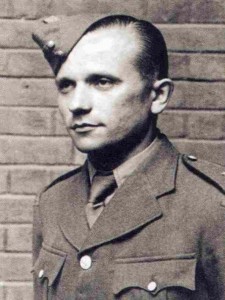
Jozef Gabčík
Jan Kubiš
Reinhard Heydrich, the target of Operation Anthropoid.
Special Operations Executive (SOE) code name for the mission to assassinate the hated SS-Obergruppenführer Reinhard Heydrich in Prague. The operation was planned for the Czech National Day in October 1941, but bad weather forced two postponements, so the team did not assemble in Czechoslovakia until late December. Eventually, after further delays, a new date was set in May 1942. The plan was to ambush the Nazi leader as he was being driven to Prague from the country mansion he occupied. The trap was set at a sharp bend in the road on the outskirts of the city; as the chauffeur-driven Mercedes slowed to negotiate the corner, two SOE men would step into the road and attack the open-topped limousine. The two SOE assassins were a pair of Czech paratroopers, Jan Kubis and Josef Gabcik, from anthropoid; they were supported by two members of out distance, a three-man team that had arrived in March, Josef Valcik and Adolf Opalka. During the ambush, Gabcik’s Sten gun jammed at the vital moment, but Heydrich was mortally wounded by a Mills grenade thrown by Kubis. The SOE men escaped the scene, only to be betrayed to the Gestapo soon afterward by the third member of out distance, Karel Curda, who identified his comrades and their hiding place in return for a reward. Curda alone survived the war-to be hanged for treachery.
ANTHROPOID was to prove controversial because of the appalling civilian reprisals taken by the Nazi occupation forces. Thousands perished in a wave of executions, and the populations of whole villages were deported to concentration camps. One village, Lidice, was systematically reduced to rubble; the site remains untouched to this day as a memorial to those who were murdered. More than 13,000 people were arrested in the aftermath of Heydrich’s assassination, prompting many to wonder whether SOE’s Czech Section had been wise to launch such a provocative operation. In fact, however, SOE did little more than give logistical support to anthropoid, for the plan was certainly Czech in origin, having been hatched by the Czech government-in-exile in London, initially with SS-Gruppenführer Karl Hermann Frank, the protektor’s hated state secretary, as the target. The assassins Kubis and Gabcik, who had transferred to the Free Czech Army from the French Foreign Legion, had been trained by SOE in Scotland and at Bellasis (STS 2) and had undergone their parachute course at RAF Ringway, but throughout they were still officially attached to the Czech 1st Brigade at Cholmondeley Castle, near Whitchurch in Cheshire. The Secret Intelligence Service was also a party to anthropoid, as confirmed by the then head of the Czech Deuxième Bureau, Colonel Frantisek Moravec, who recalled that the scheme “was necessarily shared with several officials of the British MI6, who worked with us on the technical side.” ANTHROPOID’s effect was to decimate the number of potential resisters in Czechoslovakia, reduce the willingness of the inhabitants to help parachutists, and ensure that SOE’s Czech Section would play only a peripheral role in the eventual liberation of that country.
CZECH DEUXIÈME BUREAU.
Headed by Colonel Frantisek Moravec, the Czech Deuxième Bureau was transferred to London in March 1939. It maintained a good relationship with the Secret Intelligence Service, but its links with the MY Section of Special Operations Executive (SOE) were strained to the point that SOE considered suspending operations into the Protectorate in 1943 because of a lack of knowledge about local conditions. Reprisals following anthropoid inhibited activity and cooperation, and eventually in 1944 two British military missions, MANGANESE and MICA, were established in Slovakia, supported from September 1940 by WINDPROOF, which had been intended for Hungary.